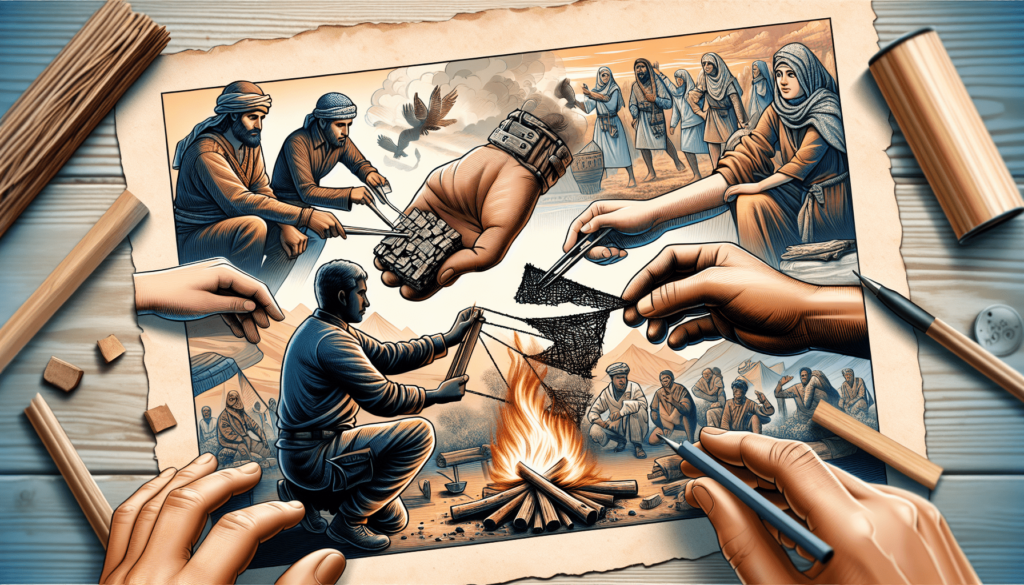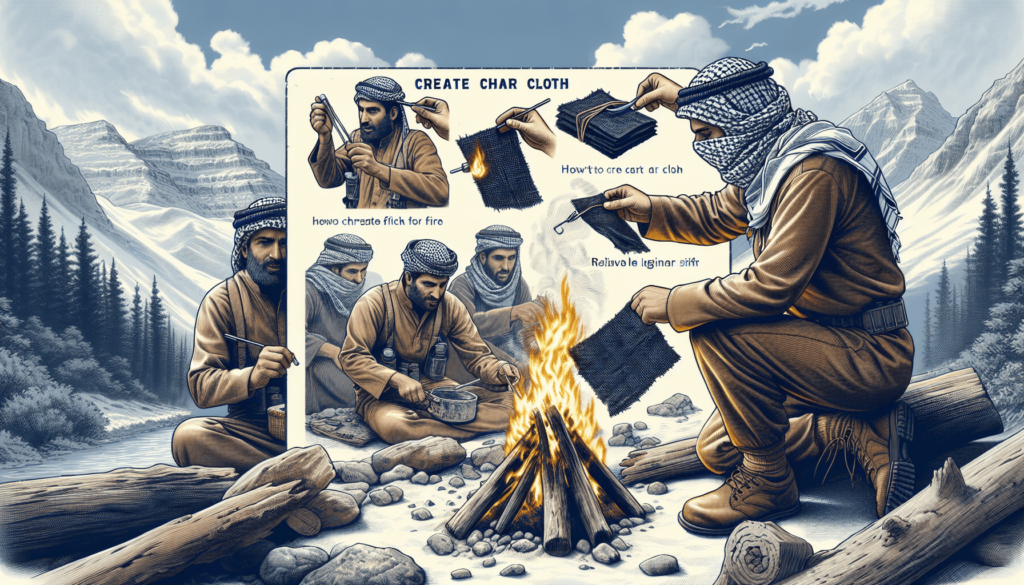Imagine being in the middle of the wilderness, surrounded by darkness, with no source of light or warmth. The chilly air bites at your skin, and desperation creeps in. But fear not, for there is an ancient art that can come to your rescue – the art of char cloth making for fire lighting. In this article, we will explore this age-old technique that has been handed down through generations, and learn how it can be used to ignite a fire even in the harshest of conditions. So grab a seat, and prepare to uncover the secrets of this mesmerizing craft.
What is Char Cloth?
Definition of Char Cloth
Char cloth is a material used for fire lighting that is made through the process of charring natural fibers in an oxygen-starved environment. The resulting charred fabric becomes highly flammable and can be easily ignited with the spark of a flint and steel, making it an invaluable tool for starting fires in various situations.
Historical Background
The art of making char cloth dates back centuries and has been utilized by various civilizations throughout history. From the ancient Egyptians to Native Americans, char cloth has been a trusted method for creating fire. It was especially prevalent during eras when modern fire-starting methods were not available. This long-standing tradition reflects the significance and reliability of char cloth in fire lighting.
Importance of Char Cloth in Fire Lighting
Char cloth plays a crucial role in fire lighting, particularly in situations where matches or lighters may not be accessible or reliable. Its ability to catch fire easily and burn slowly allows for a consistent flame, making it an essential tool in survival situations, outdoor activities, and historical reenactments. The process of making char cloth and utilizing it for fire lighting not only provides a practical solution but also allows individuals to connect with ancient traditions and embrace traditional skills.
Materials and Tools for Char Cloth Making
Selection of Fabric
When it comes to making char cloth, the choice of fabric is of utmost importance. Natural fabrics, such as cotton or linen, are the most commonly used materials due to their ability to char evenly and maintain the charred state. It is essential to avoid synthetic fabrics, as they tend to melt rather than char, rendering them ineffective for fire starting.
Cutting and Preparing Fabric
Before the fabric can be charred, it must be cut into small squares or rectangles, approximately 2 inches by 2 inches. This size allows for easy handling and ignition. Once cut, the edges of the fabric should be frayed slightly to increase the surface area for charring.
Char Cloth Container
To create char cloth, a suitable container is needed to hold the fabric during the charring process. Altoids tins, small metal cans, or tin foil pouches are commonly used containers as they provide a sealable and durable environment. It is important to ensure that the container is clean and free from any contaminants that may affect the charring process.
Fire Source
To ignite the char cloth, a reliable fire source is required. Flint and steel, ferrocerium rods (commonly known as fire starters or firesteels), or even a magnifying glass can be used to create sparks that will ignite the char cloth. It is advisable to have multiple fire-lighting tools on hand to ensure redundancy and reliability.

Process of Making Char Cloth
Preparing the Char Cloth Container
To prepare the char cloth container, it must be cleaned thoroughly to remove any residue or contaminants that could affect the charring process. Once cleaned, the container should be dried completely to prevent moisture from interfering with the charring process.
Cutting and Folding the Fabric
Using the previously cut fabric squares, fold them in half to create a smaller, concentrated area for charring. This allows for a more efficient and consistent charring process. It is important to ensure that the folded fabric fits neatly inside the char cloth container without excessive compression.
Placing the Fabric in the Container
Once the fabric is folded, it can be placed inside the char cloth container. Care should be taken to avoid overcrowding the container, as this may hinder proper charring. It is recommended to leave a small gap between each piece of fabric to allow for proper airflow during the charring process.
Sealing and Insulating the Container
After placing the fabric inside the container, it should be sealed tightly to create an oxygen-starved environment. This can be achieved by securing the lid or covering the container with tin foil and crimping the edges to ensure a tight seal. Additionally, insulating the container with a layer of aluminum foil or a similar heat-resistant material can help maintain high temperatures during the charring process.
Creating Fire Using Char Cloth
Choosing Suitable Fire-Starting Method
With the char cloth prepared, it is essential to choose an appropriate fire-starting method that complements its ignition properties. Flint and steel, for example, can create sparks that ignite the char cloth. Ferrocerium rods, on the other hand, produce hot sparks that are equally effective in igniting the char cloth. Regardless of the method chosen, it is crucial to practice proper technique and ensure a safe and controlled spark production.
Igniting the Char Cloth
To ignite the char cloth, it needs to come into contact with the spark or ember from the fire-starting method. Gently hold the char cloth against the sparks and allow them to catch fire. It is important to exercise caution during this process as the char cloth can ignite quickly and produce a strong flame.
Transferring the Flame to Tinder
Once the char cloth is ignited, the flame can be transferred to a suitable tinder material. Dry leaves, small twigs, or a bundle of fine fibers make excellent tinder choices. Carefully transfer the flame to the tinder material, nurturing it until it grows into a sustainable fire.
Building and Maintaining the Fire
With the char cloth successfully igniting the tinder, it is time to build and maintain the fire. Gradually add more fuel, such as larger sticks or logs, to ensure a steady and long-lasting flame. Regularly tend to the fire by adding additional fuel and managing the airflow to keep the fire burning efficiently.

Benefits and Advantages of Char Cloth
Ignition Reliability
Char cloth offers a high level of ignition reliability compared to other fire-starting methods. Its ability to catch fire easily and burn slowly ensures a consistent flame, even in challenging conditions. This reliability can be a lifesaver in survival or emergency situations.
Easy Transportation and Storage
One of the significant advantages of char cloth is its compact size and easy transportation. The small squares of fabric can be conveniently stored in a pouch or container, making them readily available for fire lighting wherever and whenever needed.
Versatility in Fire-Starting
Char cloth can be used with various fire-starting methods, allowing for versatility in fire lighting. Whether using flint and steel, ferrocerium rods, or a magnifying glass, char cloth adapts to different techniques and ensures a reliable ignition source.
Long Shelf Life
Char cloth has a remarkable shelf life when stored properly. Once charred, the fabric can remain in its charring state for an extended period, ready to be ignited at any time. This extended shelf life makes char cloth an excellent choice for long-term storage or emergency preparedness.
Applications of Char Cloth
Camping and Survival Situations
Char cloth is an invaluable tool for camping and survival situations. Whether starting a campfire or needing to ignite a fire for warmth and cooking, char cloth provides a reliable and efficient method for fire lighting.
Outdoor Cooking and Heating
In outdoor cooking and heating scenarios, char cloth can be used to ignite stoves, grills, or even a traditional fire pit. Its ease of use and reliability make it a practical choice for cooking meals or providing warmth in outdoor settings.
Historical Reenactments
Char cloth is often used in historical reenactments, providing participants with an authentic fire-starting method that reflects the techniques used by our ancestors. The use of char cloth in these reenactments adds an extra layer of realism and historical accuracy.
Primitive Skills Education
Char cloth is also a valuable tool in primitive skills education and bushcraft training. Teaching individuals how to make char cloth and utilize it for fire lighting allows them to connect with ancient traditions and acquire essential survival skills.
Tips and Tricks for Successful Char Cloth Making
Selecting the Right Fabric
When selecting fabric for char cloth making, choose natural fibers such as cotton or linen. These materials char more effectively and maintain their charred state, providing optimal ignition capabilities. Avoid synthetic fabrics, as they tend to melt rather than char.
Controlling the Charring Process
To achieve consistent and effective char cloth, it is crucial to control the charring process. Use an airtight container to create an oxygen-starved environment, ensuring the fabric charred evenly. Additionally, monitoring the time and temperature during the charring process can help achieve the desired results.
Proper Storage and Maintenance
To prolong the shelf life of char cloth, it is essential to store it in a cool, dry place. Moisture can affect the fabric’s ability to ignite, so keeping it in an airtight container with a moisture-absorbing packet is recommended. Regularly inspect the char cloth for any signs of degradation or deterioration and replace as needed.
Comparison of Char Cloth with Modern Fire-Starting Methods
Benefits of Char Cloth over Lighters
While lighters are convenient and readily available fire-starting tools, they can be susceptible to failure in wet or windy conditions. Char cloth, on the other hand, remains highly effective in various weather conditions, providing a reliable ignition source when other methods may falter.
Comparison to Fire Pistons
Fire pistons are traditional fire-starting tools that rely on rapid compression to generate heat and ignite tinder. While fire pistons have their advantages, such as being self-contained and compact, char cloth offers a simpler and more accessible option for beginners or those seeking a versatile fire-starting method.
Advantages in Wet Conditions
One of the notable advantages of char cloth is its ability to ignite even in wet conditions. Moisture has less impact on char cloth compared to traditional lighters or other fire-starting methods. This makes char cloth an excellent choice for outdoor enthusiasts or survival situations where dry tinder may be challenging to find.
Safety Considerations
Open Flames and Ventilation
When using char cloth, it is important to ensure there is adequate ventilation and a clear and open space. Open flames can be unpredictable, so minimizing the risk of accidental ignition or spreading fire is crucial. Avoid using char cloth in confined spaces or areas where flammable materials are present.
Handling Hot Containers
Char cloth containers can become hot during the charring process. When removing the container from the heat source or handling the char cloth, it is essential to use heat-resistant gloves or tools to prevent burns. Exercise caution and allow the container to cool before handling directly.
Preventing Burns and Accidents
When working with fire-starting tools or char cloth, it is easy to get burnt if not careful. Always be mindful of your surroundings, keep flammable materials away from the open flame, and never leave a fire unattended. Take necessary precautions and have fire safety equipment on hand, such as a fire extinguisher or water source, in case of emergencies.
Conclusion
In summary, the art of making char cloth for fire lighting is a time-honored tradition that has stood the test of time. Its reliability, portability, and versatility make it an essential tool in survival situations, outdoor activities, historical reenactments, and primitive skills education. By understanding the materials, process, and benefits of char cloth, individuals can embrace traditional skills and ignite a deeper connection to the ancient art of fire lighting. So go ahead, make your own char cloth, and embrace the power of this ancient technique in igniting your fires.
